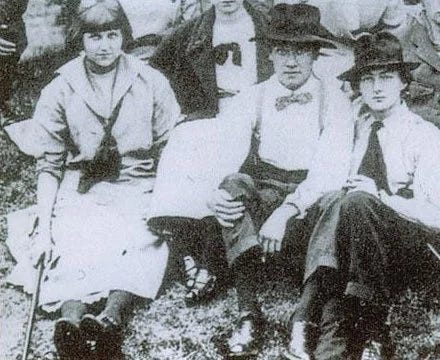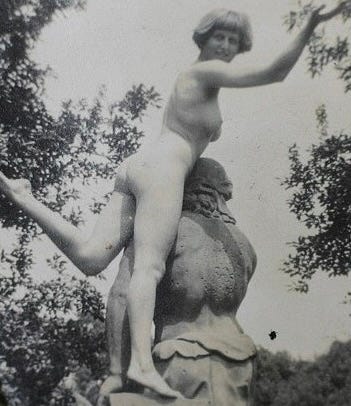Dora Carrington: A Brilliant Life
"Her great talent for drawing and painting was obvious to everyone."

Though not generally considered a key member of the Bloomsbury Group, painter, decorative artist, and early feminist Dora Carrington lived at the heart of the group, and her association with them has seen her name added to many Bloomsbury-fringe lists.
A bohemian and maverick who liked to play with boundaries, Dora’s personal life was as interesting as her art. She was involved in one of Bloomsbury’s most famous menages a trois - loved, and was loved by both men and women and artistically drew from several significant movements, including Impressionism, Primitivism and Surrealism.
Dora Carrington was born Dora de Houghton Carrington in a house named Ivy Lodge in Hereford on the 29th of March 1893. She was the fourth of five children of Charlotte Houghton, a governess, and Samuel Carrington, a railway engineer.
Although Carrington adored and revered her father, sketching him almost obsessively, she did not admire her fussy, martyr-like mother, who crammed the house with ornaments and devoted herself to charity work and religious causes.1
From an early age, Dora used art as a means of escape. When the family moved to Bedford, she attended Bedford High School, where her talents were recognised and encouraged, and she attended extra art classes in the afternoon. In 1910, aged seventeen, she won a scholarship to study at the Slade School of Fine Art.
At school, Dora's work was indifferent except in natural history and art, but her great talent for drawing and painting was obvious to everyone....2
The Slade, the art school of University College, London, was founded in 1871 and had an outstanding reputation with alumni including Walter Sickert and Augustus John. Though prestigious, it was less traditional than its neighbour, the Royal Academy of Art, and Dora embraced her new found-freedom, cutting off her long hair into a short bob - very daring in the days before the ‘flapper’ hairstyle of the 1920s - dropping her first name and being reborn as Carrington.
Carrington made strong and lasting friendships at the Slade, including with Barbara Hiles and Dorothy Brett, who also cut their hair short and dropped their first names - the three became known as the Cropheads. And also with talented artist Mark Gertler whose oil paintings influenced her own work. Gertler, along with fellow students and famous alumni John and Paul Nash and Richard Nevinson, fell deeply in love with Carrington, attracted by her passion and free spirit.
She was an attractive and popular figure with her large blue eyes and her shock of thick hair bobbed in the fashion she had set... Moreover, her individual sense of fun and fantasy made her an enchanting companion…3
While John and Paul Nash were happy to eventually settle for friendship, Carrington fell into what was likely her first love triangle with Gertler and Nevinson. Though she did not progress into a sexual relationship with either, and Gertler and Nevinson had been the closest of friends previously, their friendship was the casualty of their obsession.
I am writing here to tell you that our friendship must end from now, my sole reason being that I am in love with Carrington and I have reason to believe that you are so too. Therefore, much as I have tried to overlook it, I have come to the conclusion that rivals, and rivals in love, cannot be friends.
Letter from Gertler to Nevinson
Carrington worked hard at the Slade, won a number of prizes, and completed her studies in 1914. Following her graduation and with friends in common, she began working on paintings and woodcuts for Roger Fry’s Omega Workshop - where she was introduced to other members of the Bloomsbury Group
It was a marvellous combination of the highest intelligence, & appreciation of literature combined with a lean humour & tremendous affection. They gave it backwards and forwards to each other like shuttlecocks, only the shuttlecocks multiplied as they flew in the air.4

At a party at Asheham House, Virginia and Leonard Woolf’s weekend retreat, she met Lytton Strachey - critic, biographer, and the Bloomsberry that would change her life.
Attracted to Carrington from the moment he first laid eyes on her, he had boldly tried to kiss her during a walk across the South Downs, the feeling of his beard prompting an enraged outburst of disgust from the unwilling recipient. According to legend, Carrington plotted frenzied revenge, creeping into Lytton's bedroom during the night with the intention of cutting off the detested beard. Instead, she was mesmerized by his eyes, which opened suddenly and regarded her intently. From that moment on, the two became virtually inseparable.5

Although Lytton was openly gay, Carrington fell in love with him, and they began living together at Mill House in Tidmarsh, Berkshire, in 1917.
In 1918, she met literary journalist Ralph Partridge, an old Oxford friend of her younger brother Noel. On the 4th of July that year, she wrote to Lytton:
Partridge shared all the best views of democracy and social reform... I hope I shall see him again - not very attractive to look at. Immensely big. But full of wit, and recklessness.6
Ralph fell in love with Carrington and moved into Mill House with her and Lytton - who fell in love with Ralph. In 1921, Carrington accepted a proposal of marriage from Ralph - not out of love, but so the three of them could continue to live together safely outside the traditions of a normal marriage.
On the day that she accepted the proposal, she wrote to Lytton:
I cried last night Lytton, whilst he slept by my side sleeping happily—I cried to think of a savage cynical fate which had made it impossible for my love ever to be used by you...7
Carrington and Ralph married later that year. Lytton paid for the wedding and joined them on their honeymoon to Venice.
In 1924, the three of them moved together to Ham Spray House in Wiltshire. But, their relationship began to wane, and, in 1926, Ralph moved to London with Frances Marshall, and Carrington began an affair with his friend, Bernard Penrose. This ended sourly, however, when she became pregnant and, refusing to commit to Penrose, had an abortion. He would be her last affair with a man.
Carrington’s life fell apart in devastating circumstances when Lytton died of undiagnosed stomach cancer on the 21st of January 1932, aged fifty-one, following a period of ill health.
They say one should keep your standards & your values of life alive. But how can I when I only kept them for you. Everything was for you. I loved life just because you made it so perfect & now there is no one left to make jokes with or talk to... I see my paints, & think it is no use for Lytton will never see my pictures now, & I cry.8
Two months later, on the 11th of March, and wearing Lytton’s dressing gown, Carrington shot herself. Though she was discovered, and her friends Ralph Partridge and David Garnett were able to say goodbye - she died of her injuries later that day. She was just thirty-eight.
Carrington was cremated, and her ashes were buried under the laurels in the garden at Ham Spray House. In 1970, Garnett, writer and former lover of Bloomsbury artist Duncan Grant published her letters and diaries - securing her legacy and connection to the Bloomsbury Group.

Thank you for reading! If you enjoyed this biography, please like and/or share. And, as always, I would love to know your thoughts in the comments. If you wish, you can also Become a Member and/or read the suggested Beyond Bloomsbury posts below. Until next time…
Images:
Images on Beyond Bloomsbury are usually credited. I conduct thorough picture research, but please let me know if you believe a credit needs to be added or corrected. Thank you!
Sources and Recommended Reading:
Carrington, N. Carrington: Paintings, Drawings and Decorations. 1978.
Chisholm, Anne. Carrington’s Letters: Her Art, Her Loves, Her Friendships. 2017.
Curtis, Vanessa. Virginia Woolf’s Women. 2002.
Garnett, David, ed. Carrington: Letters and Extracts from her Diaries. 1970.
Gerzina, Gretchen. Carrington: A Life of Dora Carrington 1893-1932. 1989.
Holroyd, Michael. Lytton Strachey: A Critical Biography. Two Volumes. 1967-68.
Partridge, Frances. Love in Bloomsbury: Memories. 1981.
Curtis, Vanessa. Virginia Woolf’s Women. 2002.
Gerzina, Gretchen. Carrington: A Life of Dora Carrington 1893-1932. 1989.
Partridge, Frances. Love in Bloomsbury: Memories. 1981.
Garnett, David, ed. Carrington: Letters and Extracts from her Diaries. 1970.
Curtis, Vanessa. Virginia Woolf’s Women. 2002.
Garnett, David, ed. Carrington: Letters and Extracts from her Diaries. 1970.
Ibid.
Ibid.














I spent many years studying the Bloomsbury group. None of the stories got to me near as much as Carrington and Strachey. Wonderful essay. I'd never seen the photograph of her at play before.
What a brilliant biography of such a remarkable character! I remember reading your shorter bio on Carrington but this has sparked even more interest in her. Aside from her paintings, she sounds like a fascinating character. I love the photograph of her!